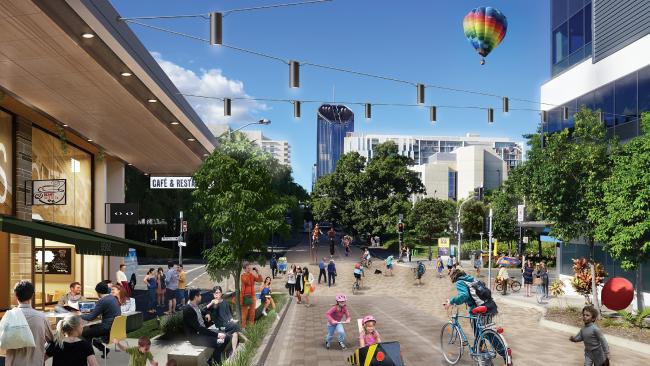What Should We Make of the Vision South Bank Report?
Most of the ideas in Business South Bank’s recent Vision South Bank report are not new, and have been in the public domain for some time, but putting them into one place serves as a useful starting point for further planning.
South Bank is of immense importance to so many Brisbanites, and while this report is a valuable contribution to plans for the precinct’s future, it should be seen as just one perspective in a broader conversation. Every resident should be offered a meaningful say in the future of South Bank, rather than leaving these decisions up to a few design experts and elite power-holders.
I offer the following reflections in the hope that future detailed planning documents will benefit from constructive criticism.
[Related reading: South Bank To Grow By Two-Thirds Under New ‘Vision’]

Concept plan for the Kurilpa Waterfront: "Vision South Bank"
Homelessness and Gentrification
One demographic which would be very significantly affected by the report’s proposals, but whose voice has been largely silenced and sidelined, are the many rough sleepers who live around South Brisbane. The report contemplates expansion of South Bank along the Kurilpa Peninsula, and greater connectivity to Musgrave Park. Both of these areas are gathering places for people whose presence has been increasingly criminalised in other parts of the inner-city.
South Bank’s origin story is one of displacement and upheaval. The development and "revitalisation" that came with Expo 88 saw many low-income residents forced out of the South Brisbane area, dispersing and fragmenting their communities. Today, South Bank is a much more accepting, diverse and egalitarian space, however some of its policies – such as ‘closing’ at midnight – do continue to impact negatively on homeless Brisbanites, even if this might not be South Bank’s intention.
Any proposal to expand South Bank westwards around the Kurilpa Peninsula, or to increase connectivity and lead more tourists through to Musgrave Park, needs to start by identifying and proposing solutions to deliver well-designed affordable housing within the 4101 postcode that can accommodate rough sleepers. Any changes to how these spaces are governed and controlled should focus on supporting and empowering marginalised people who use these parks, rather than forcing them out.
My main concern is that if the reach of South Bank Corporation were extended to these other green spaces, these areas will be more heavily policed by security guards and more heavily influenced by the wishes of high-end businesses and corporate events organisers. Over time, the social norms about what activities and kinds of behaviour are considered acceptable in these parks would change, and marginalised demographics would again find themselves displaced and pushed away.
Respecting Aboriginal Sovereignty
You could write all day about Musgrave Park and still only scratch the surface of its significance to First Nations people. No significant changes should be contemplated for Musgrave Park unless all the various Aboriginal community stakeholder groups are meaningfully involved in the conversation. Importantly, there’s a distinction between top-down consultation where you ask community groups whether they support a proposal, as opposed to projects which are defined and driven by Aboriginal people themselves.

Indigenous dancers perform at the Musgrave Park Family Fun DayI expect that the mention of an Aboriginal Cultural Centre in Musgrave Park will attract strong community support, as this is something that local Murri elders have been requesting for many years. However it’s crucial that planning and decision-making power rests with the Aboriginal community itself, rather than a project like this being driven and delivered by South Bank Corporation or Business South Bank.
Different Roles for Different Kinds of Green Space
A sustainable, liveable city requires several different kinds of green space that fill different needs. South Bank is a busy tourist destination, where the few open green spaces are often used for large public events. It’s not the best place to go if you want to kick a ball, fly a kite, or organise a community meeting with some neighbours on your street. South Bank is also very strongly opposed to any kind of protest activities taking place within the parklands, which means that an expansion around the Kurilpa peninsula could neutralise the existing use of that space as a meeting point for rallies and marches.
Anyone who spends a bit of time at Musgrave in the afternoons or on weekends will observe residents hanging out on park benches chatting, families enjoying the playgrounds, and people exercising and playing sport. Musgrave Park plays the role of a quiet retreat in the middle of a busy suburb, as well as being a hub for community events and protest movements. Any changes to the park will need to keep these existing roles in mind.
Not all green space is created equal, and the needs of local residents are not necessarily 100 per cent compatible with the uses that riverside parkland might be put to if amalgamated into South Bank. The benefits of expanding South Bank as a citywide destination must be balanced against nearby apartment residents’ need for local neighbourhood parks that are less heavily curated and controlled, and not subject to the same intensity of use.
I’ve written a bit about the report’s ideas on the Maritime Museum in the longer version of this piece. My main concern is that as a government-owned site, free public river access must be preserved and increased, with no further private riverside restaurants.
Connectivity
Glenelg Street
The report’s vision for opening up Glenelg Street as a leafy pedestrian boulevard would greatly improve pedestrian connectivity between South Bank and West End, and if designed well, could also double up as a wildlife corridor between Musgrave Park and the river.
However, the southern end of Glenelg leading up to Musgrave is quite steep, and for this reason it probably shouldn’t be the primary connector for cyclists or people with impaired mobility. As well as supporting a green boulevard on Glenelg Street, Business South Bank should also push for any redevelopment projects between Cordelia and Merivale to include new pedestrian laneways through this precinct.
The report’s vision for Glenelg would require prioritising pedestrian movements ahead of vehicles that travel along both Merivale and Cordelia. Pushing Merivale St underground sounds great, but probably wouldn’t be worth the immense cost, particularly in such a flood-prone location. A gradually sloping pedestrian overpass might be more feasible, and could become a significant architectural landmark. Either way, Merivale and Cordelia will hopefully become slower streets in future that offer more space (and priority) to pedestrians and cyclists, as private cars are gradually banished from the inner-city.

An artist’s impression of the new “Festival Street” along Glenelg St, linking South Bank to Musgrave Park: Vision South Bank
Cycling
Conflicts between cyclists and pedestrians around South Bank Parklands are increasing. Grey St is rightly perceived as unsafe due to cars pulling in and out of street parking bays without giving way to bikes. As a result, many commuter cyclists still choose the riverside walkway, causing near misses with pedestrians.
Brisbane City Council’s Metro Project will be substantially reducing cyclist access across Victoria Bridge, removing the on-road bike lanes. The reduction in bike access over Victoria Bridge may see more cyclists travelling through South Bank towards the Goodwill Bridge or over to the Kurilpa Bridge. The fact that the proposed bridge to the Queens Wharf casino is intended to be closed to cyclists is a huge mistake and lost opportunity.
A better solution would be to leave the riverside path for pedestrians and recreational bike riders, and discourage motor vehicle traffic along Grey Street to improve cycling safety and convenience. Closing Grey St where it meets Melbourne St, replacing street parking with loading zones and pocket parks, and dropping the speed limit to 20km/h would turn it into a primary cycling route through South Brisbane.
The Vision South Bank report’s general ideas about improving connectivity are positive, but Business South Bank should have been a bit braver, and called for a substantial reduction in car access throughout the precinct.
Private water taxis?
Water taxis in Brisbane could be cool, but the only way I can imagine a private industry being commercially viable is if all other modes of land-based transport became so unreliable and inefficient that customers were willing to pay high premiums for river-based alternatives. But I don’t really want to live in a city where most of us are crammed onto crowded buses or stuck in traffic congestion while a wealthy few get to zip back and forth across the water in Uber-ferries.
There’s also a real (but not insurmountable) risk that private cross-river taxi services might create excessive congestion, slowing the public ferry and CityCat services. Large numbers of private ferries continually crossing between South Bank and the CBD would probably impact the reliability and frequency of river-based public transport.
If there’s a genuine need for more tourist-friendly cross-river transport services, abolishing fares for all of the council’s existing small ferries is a good place to start. It would certainly improve efficiency if every patron didn’t have to swipe their GoCard when getting on and off.
As much as possible, South Bank should prioritise and support public transport services on the river, rather than building infrastructure on public land that’s primarily for user-pays private water taxi companies.
Ongoing need for Kurilpa Masterplan
Although it’s not perfect, this report is a useful injection into public debate about the future of South Bank Parklands. However, Vision South Bank should not be treated as a proxy for detailed democratic masterplanning, nor should it be seen as reflective of the needs and desires of other stakeholders beyond those who contributed to it directly.
The design and development of further green spaces along the river must give more power to residents and must resist pressure from the property industry to maximise the density of private dwellings and minimise public space.
Any redevelopment of publicly-owned land in 4101 should primarily be restricted to public green space, community and cultural facilities, and public housing. High-rises should be kept well back from the river, and planning decisions to further upzone sites for higher density should not go ahead without broad community support.
I commend Business South Bank for producing the Vision South Bank report, and I hope the concerns I’ve raised – particularly with regard to respecting Aboriginal sovereignty, consulting democratically and managing the negative impacts of gentrification – will be taken on board going forward.
A more detailed response to the report can be found at jonathansri.com/visionsouthbank
Feature image credit: TkKurikawa

Jonathan Sri
is the Councillor for the Gabba Ward in Brisbane's inner-south. Jonathan is a passionate cyclist and a strong public transport advocate. He believes our current political system is being undemocratically influenced by large corporations, and that many of the laws and policies which govern society tend to serve the interests of a privileged elite minority rather than ordinary residents. Jonathan took part in the Great Debate at Urbanity '17.
The Urban Developer will occasionally publish opinion pieces written by outside contributors representing a wide range of viewpoints.














